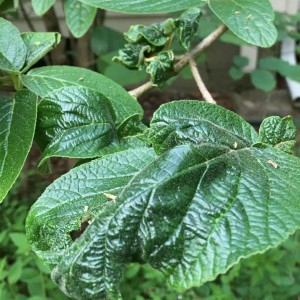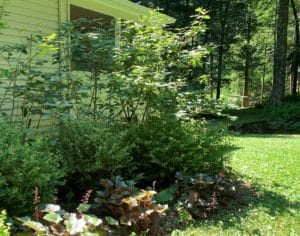Hello fellow readers, The reasons to prune are similar to the reasons for caring for ourselves and our families– Improving appearance and health, training the young, controlling size, preventing injury or damage, rejuvenating the old, and influencing bounty. But choosing the right plant is the first step to limit the need for pruning. Then there are times that desperate measures call for rejuvenation pruning.
How to choose plants appropriate in size for the area
While planning a new foundation planting, Darren from Hackettstown, NJ, asked about pruning. With proper plant selection and placement, he won’t have to prune for years. Choose plants appropriate in size for the area, allowing space to grow. It’s a common mistake to plant young plants too close to the foundation. Find out the mature widths and heights, and space accordingly. For example, a shrub that matures 10 feet high and 5 feet wide should be planted 5 feet apart from the center of the plant. For trees, spacing them by half their width at maturity is a basic rule of thumb but not a catchall as there are variables such as growth rates. For a fast-growing tree, you may wish to space further. Or, if you are seeking a quick screen, plant closer together.
So while Darren won’t have to control size for a while, he’s wise to think about the other reasons to prune. It’s best to train while young rather than have to rejuvenate when old, which parallels the adage of keeping fit. In general, once your plants reach the desired size, you can prune the new growth every year right after bloom to maintain its size. I wish it were that easy for us!
Rejuvenation pruning – the story of an aphid invasion
Then there are desperate situations that call for drastic measures. My Viburnum rhytidophyllum, Leatherleaf Viburnum, has gotten beyond desperate in terms of invaders sucking the life out of their leaves. Over the last few years, aphids have caused severe leaf curl disfigurement, and the plants look bloody awful. I’ve treated them with Neem Oil, a natural alternative to synthetic pesticides, but the leaves curl tightly.
If you don’t intervene early enough, the oil won’t successfully suffocate the suckers. Indeed, I didn’t apply the oil often enough either; they say every five to seven days. After the bloom, I cut each stalk down in varying heights from one to three feet, removing all remaining lower leaves. Yes, a desperate measure, but I think there’s enough storage in the root systems to rejuvenate the plants. Next week I’ll share my interim solution to camouflaging the ‘uglies’ while the plants recover.
The topic of pruning can’t go without mention of one of the top pet peeves – sheering shrubs into meatballs or hockey pucks. I think meatballs are far more appealing in pasta bowls, not along a foundation.
Garden Dilemmas? AskMaryStone@gmail.com (and now on your favorite Podcast App.)
Click through to a solution for a quick camouflage Castor Beans Plants hide ‘Uglies.’
Column updated July 5, 2020
This column is featured in Episode 29 of the Garden Dilemmas Podcast






